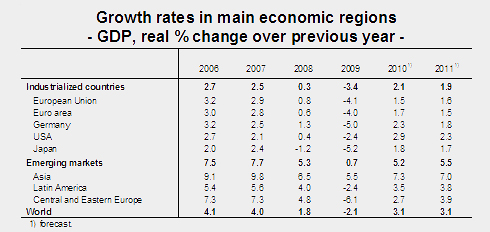Although the recovery appeared to be stalling at the end of 2009, the latest indicators show the economy getting off to a positive start to 2010. In its latest economic forecast for Germany, Allianz expects to see growth of 2.3 percent in 2010 and 1.8 percent in 2011. "The positive outlook for exports, the expected modest pickup in private consumption, the substantial boost from the stimulus packages and catch-up processes following the severe winter all point to buoyant growth from the second quarter of 2010," said Michael Heise, Chief Economist at Allianz.
Outlook for German economy good
German exports already started to recover strongly in the second half of 2009. Given the fall in the external value of the euro and the recovery in the world economy, exports are set to increase further in 2010. Thanks to the relatively stable German labor market, consumer demand bolstered the German economy in 2009. In 2010 the situation on the labor market will remain robust and consumer demand will pick up slightly. The stimulus packages will provide a boost in 2010 to the tune of around 55 billion euros. As the bulk of the stimulus packages comprises permanent tax reductions and increased transfers, some two-thirds of this will have a permanent impact. However, with expenditure-side measures due to expire, economic growth will slow markedly in the first half of 2011. But the economists already see the economy accelerating gradually again at the end of 2011.
The steep slide in the German economy in the wake of the financial and economic crisis once again highlighted Germany's reliance on foreign trade. But the German economy will remain geared to exports. "Given ongoing globalization and further growth in world trade, it would be totally absurd for Germany to forgo the contribution to growth from exports. But this does not necessarily have to result in a foreign trade surplus, " said Heise.
Buoyant growth in the domestic economy helps reduce the foreign trade surplus via higher imports and Germany has an underused domestic demand potential. However, the Allianz economists see this not so much as a problem of too low consumption but rather of too low investment. In 2008 the non-financial asset formation of German companies amounted to only 3.1 percent of gross domestic product. The stock of German direct investment abroad in 2007 was some 200 billion euros higher than the stock of foreign direct investment in Germany. Germany's industrial capital stock has remained flat since the year 2000. This illustrates that Germany needs to become more attractive as an investment location.
A favorable backdrop for investment can only be achieved with the aid of a growth policy geared to the long term. The key factors defining the attractiveness of an investment location include public infrastructure, the level of education and qualification of the workforce, labor costs in relation to productivity, labor market flexibility and the tax system. Heise: "In recent years policymakers have achieved marked improvements on a number of fronts. In view of growing global competition and the steady improvement evident in the emerging markets, every effort should be devoted in the coming years to promoting the propensity to investment at home. Higher investment activity would not only have a positive impact on economic growth but would also help reduce the foreign trade surplus. This would benefit our European partners without undermining Germany's export prowess."


You can find the full forecast at: www.group-economics.allianz.com under Publications/Working Papers.
Currently only available in German. English version available soon.
As with all content published on this site, these statements are subject to our Forward Looking Statement disclaimer.
Link to the disclaimer